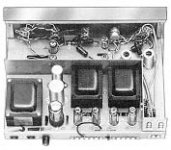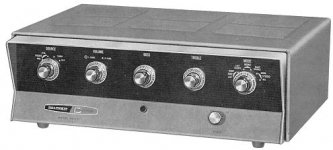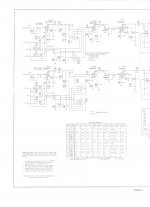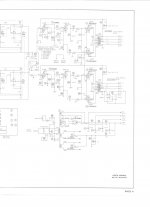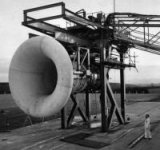I think now the amps coded 'AA' something were all sold outside the UK, mostly in the USA, and maybe around the rest of the world.
There's the odd Brit comment about them in one or two forums here, but still no schematic.
It would be interesting to see if the MA-12 schem. is an exact copy of the 5-10.
Your picture shows an original chassis with no 'missing tubes'.
What I have learned seems to be that when people refurbish and maybe re-chassis the MA-12's, they either modify the EF86's wiring, as all that gain isn't needed these days, or they just get rid of it, leaving 3 tubes and a rectifier per channel..
That would make sense. Easy to check your amps to see if the 12AX7's are wired the same as the 5-10.[/QUOTE]
jeff
There seems to be some confusion in this thread about what constitutes a Mullard or a Williamson. Another schematic also appeared showing what seems to be a Dynaco circuit. While it doesn't really matter in the grand scheme of things what labels we put on these different topologies,such vagueness can lead to misinterpretation.
To clarify:
*The Mullard approach (pentode IP stage, unbalanced LTP triode splitter/driver and pentode/UL P-P OP tubes) is normally quite stable even using a great amount of GNFB but has excessively high loop gain, especially for easily driven EL84s. It is common practice to modify the 5-10 or 5-20 to improve a number of things, e.g. reducing loop gain, balancing the splitter with a CCS tail, using a lower Rp double triode as splitter/driver, applying fixed bias).
* The Dynaco approach (pentode IP stage, triode concertina splitter and pentode/UL P-P OP tubes), works perfectly well for easily driven EL84s but is a poor solution for driving bigger OP tubes. This is an extremely basic approach and its unsatisfactory performance with bigger OP tubes is the reason for the existence of many after-market improvement kits.
* The Williamson approach (triode IP stage, triode concertina splitter, twin triode differential driver and triode (or pentode UL) P-P OP tubes) overcomes the problem of a poor concertina driver in the Dynaco but icludes an extra stage to the GNFB loop, making stability a challenge for the unwary. I see a Williamson as overkill for EL84 OP tubes.
To clarify:
*The Mullard approach (pentode IP stage, unbalanced LTP triode splitter/driver and pentode/UL P-P OP tubes) is normally quite stable even using a great amount of GNFB but has excessively high loop gain, especially for easily driven EL84s. It is common practice to modify the 5-10 or 5-20 to improve a number of things, e.g. reducing loop gain, balancing the splitter with a CCS tail, using a lower Rp double triode as splitter/driver, applying fixed bias).
* The Dynaco approach (pentode IP stage, triode concertina splitter and pentode/UL P-P OP tubes), works perfectly well for easily driven EL84s but is a poor solution for driving bigger OP tubes. This is an extremely basic approach and its unsatisfactory performance with bigger OP tubes is the reason for the existence of many after-market improvement kits.
* The Williamson approach (triode IP stage, triode concertina splitter, twin triode differential driver and triode (or pentode UL) P-P OP tubes) overcomes the problem of a poor concertina driver in the Dynaco but icludes an extra stage to the GNFB loop, making stability a challenge for the unwary. I see a Williamson as overkill for EL84 OP tubes.
Yes !
Hi Jeff
Yes the 'Heathkit Daystrom Ltd' MA-12 is quite simply a Mullard 5-10 clone, like a few other similars, such as the Leak 20 ?
I havent checked the wiring yet, but it just has to be.
It even uses the Mullard recomended mains and output transformers made in England by 'Hinchley'.
This is why there is a bit of talk on one or two of the English forums on how to rewire the EF86, or get rid of it.
I think the favoured way from what I can make out is to leave it in and wire it as a triode like the Germans did in microphones.
As far as I can tell no American Heathkits ever had an EF86 in them.
The MA-12 was produced some time between 1954 and 1962, as this is when Daystrom Ltd had an interest in the company, in 1962 Daystrom Ltd got into the oil buisness for some reason.
The guy I thought had refurbished MA-12's a few posts ago, actualy has a re-boxed AA-151 which looks in terms of parts and transformers, just like a MA-12, but is American made and is another variant of the GZ34 / EL84 scheme that ALL the 10/12 watt-ish amps had.
I didn't manage to find a schematic for the AA-151, but I found a couple of photos of what it would have looked like before re-casing, so I'll post those just to confuse everyone even more ! (just kidding Kid).
Cheers Simon...
PS - The MA-12 has the bigger GZ34 rectifier, where the original Mullard 5-10 had a smaller B9 type.
I asume Heathkit Daystrom Ltd just threw this in as their units had to power the optional preamp as well. Pheeww!
I think thats the story.
jeff[/QUOTE]It would be interesting to see if the MA-12 schem. is an exact copy of the 5-10.
That would make sense. Easy to check your amps to see if the 12AX7's are wired the same as the 5-10.
Hi Jeff
Yes the 'Heathkit Daystrom Ltd' MA-12 is quite simply a Mullard 5-10 clone, like a few other similars, such as the Leak 20 ?
I havent checked the wiring yet, but it just has to be.
It even uses the Mullard recomended mains and output transformers made in England by 'Hinchley'.
This is why there is a bit of talk on one or two of the English forums on how to rewire the EF86, or get rid of it.
I think the favoured way from what I can make out is to leave it in and wire it as a triode like the Germans did in microphones.
As far as I can tell no American Heathkits ever had an EF86 in them.
The MA-12 was produced some time between 1954 and 1962, as this is when Daystrom Ltd had an interest in the company, in 1962 Daystrom Ltd got into the oil buisness for some reason.
The guy I thought had refurbished MA-12's a few posts ago, actualy has a re-boxed AA-151 which looks in terms of parts and transformers, just like a MA-12, but is American made and is another variant of the GZ34 / EL84 scheme that ALL the 10/12 watt-ish amps had.
I didn't manage to find a schematic for the AA-151, but I found a couple of photos of what it would have looked like before re-casing, so I'll post those just to confuse everyone even more ! (just kidding Kid).
Cheers Simon...
PS - The MA-12 has the bigger GZ34 rectifier, where the original Mullard 5-10 had a smaller B9 type.
I asume Heathkit Daystrom Ltd just threw this in as their units had to power the optional preamp as well. Pheeww!
I think thats the story.
Attachments
Hi there Ray Moth
Hi Ray Moth
Yes, there was no confusion over Williamson and Mullard.
The main point of this investigation into the MA-20's was to try and establish whether the MA-20's had any connection to the American EL84 Heathkits some of which do resemble Dynaco type products.
It has been most surprising to me, not to have fairly easily found documentation on the net for the MA-12, perhaps the reason for this is that the Mullard 5-10 is so well documented there is no need for MA-12 details as they are in fact the same thing.
It is still surprising however that since a vast number were probably sold, that there isn't even documentation for the Heathkit Daystrom preamp which sold along side the MA-12 and which I in fact used to have a pair of as well.
Got there in the end.
Cheers Simon...
There seems to be some confusion in this thread about what constitutes a Mullard or a Williamson. Another schematic also appeared showing what seems to be a Dynaco circuit. While it doesn't really matter in the grand scheme of things what labels we put on these different topologies,such vagueness can lead to misinterpretation.
Hi Ray Moth
Yes, there was no confusion over Williamson and Mullard.
The main point of this investigation into the MA-20's was to try and establish whether the MA-20's had any connection to the American EL84 Heathkits some of which do resemble Dynaco type products.
It has been most surprising to me, not to have fairly easily found documentation on the net for the MA-12, perhaps the reason for this is that the Mullard 5-10 is so well documented there is no need for MA-12 details as they are in fact the same thing.
It is still surprising however that since a vast number were probably sold, that there isn't even documentation for the Heathkit Daystrom preamp which sold along side the MA-12 and which I in fact used to have a pair of as well.
Got there in the end.
Cheers Simon...
I didn't manage to find a schematic for the AA-151, but I found a couple of photos of what it would have looked like before re-casing, so I'll post those just to confuse everyone even more ! (just kidding Kid).
I'll email you a copy of the schem. Be prepared to be disappointed.
jeff
There is a site with a good write up on the 5-10 that includes the chassis layout:
Mullard 5-10 Ten Watt Amplifier
There is an interesting Heathkit UA-1 Schematic on the Vintage Radio site:
http://www.vintage-radio.info/heathkit/
It uses only 4 tubes, but it looks like it might originally have had 5 and switched to a combined Pentode/Triode (6AN8) to reduce package count.
Mullard 5-10 Ten Watt Amplifier
There is an interesting Heathkit UA-1 Schematic on the Vintage Radio site:
http://www.vintage-radio.info/heathkit/
It uses only 4 tubes, but it looks like it might originally have had 5 and switched to a combined Pentode/Triode (6AN8) to reduce package count.
Last edited:
Heathkit AA-151 Schematic Of Preceding Amp Photos
Hi Jeff VK
Thanks for you interest and help with the quest again.
There's no way I will be disappointed to see the AA-151 Schematic.
The photos of the amp rebuild a few post's ago, clearly shows what one music lover has chosen to do with his old Heathkit EL84 amp.
It would be great Jeff if you posted it here with the title 'Heathkit AA-151 Schematic', it looks like it might be one of those slightly hard to find ones and it would be great if search engines picked up on it for others to see.
I'm going to post again soon with the question to members who might be reading this:-
"OK we know what it is now and we've gone through a bit of history along the way. But the question the very first post in the thread hints at is; We've got these amps here that need a bit of TLC, what are we going to do with them ?"
Cheers... Simon...

I'll email you a copy of the schem. Be prepared to be disappointed.
jeff
Hi Jeff VK
Thanks for you interest and help with the quest again.
There's no way I will be disappointed to see the AA-151 Schematic.
The photos of the amp rebuild a few post's ago, clearly shows what one music lover has chosen to do with his old Heathkit EL84 amp.
It would be great Jeff if you posted it here with the title 'Heathkit AA-151 Schematic', it looks like it might be one of those slightly hard to find ones and it would be great if search engines picked up on it for others to see.
I'm going to post again soon with the question to members who might be reading this:-
"OK we know what it is now and we've gone through a bit of history along the way. But the question the very first post in the thread hints at is; We've got these amps here that need a bit of TLC, what are we going to do with them ?"
Cheers... Simon...

Thanks Very Much The Gimp
Hi TG
Thanks very much for your links and your interest in the thread.
I have a feeling that this could be an amazing journey of history and discovery, deciding what to do with these amps and how to refurbish them.
It's great to be on the site where who knows what gems of knowledge and information members will come up with next.
There must be loads of members out there listening to loads of different EL84 amps with loads of stuff to say about them, not just in technical terms, but also how they sound, and how to get the best from this small but very good sounding Mullard valve.
It looks like the MA-12's I have are essentialy Mullard 5-10's as the thread suggests.
The question now is WHAT to do with them ?
My intention is not neccesarily to 'restore' them to exactly how they were.
But to 'refurbish' them into something that will be of maximum benefit to me today.
ie. if I don't come up with a plan that results in having a pair of amps that I want to and indeed do listen to then the plan will have failed.
I do think faithfull restorations are totaly valid if that is the intention of the builder, but I'm not nostalgic for these amps or running a museum, but would love to end up with some thing I'd be happy to listen with for many years.
Any further EL84 rebuilding info and listening opinions from you or other members would be most welcome.
Thanks again for your interest TG.
Cheers...Simon...

There is a site with a good write up on the 5-10 that includes the chassis layout:
Mullard 5-10 Ten Watt Amplifier
There is an interesting Heathkit UA-1 Schematic on the Vintage Radio site:
Heathkit Schematic Diagram Archive
It uses only 4 tubes, but it looks like it might originally have had 5 and switched to a combined Pentode/Triode (6AN8) to reduce package count.
Hi TG
Thanks very much for your links and your interest in the thread.
I have a feeling that this could be an amazing journey of history and discovery, deciding what to do with these amps and how to refurbish them.
It's great to be on the site where who knows what gems of knowledge and information members will come up with next.
There must be loads of members out there listening to loads of different EL84 amps with loads of stuff to say about them, not just in technical terms, but also how they sound, and how to get the best from this small but very good sounding Mullard valve.
It looks like the MA-12's I have are essentialy Mullard 5-10's as the thread suggests.
The question now is WHAT to do with them ?
My intention is not neccesarily to 'restore' them to exactly how they were.
But to 'refurbish' them into something that will be of maximum benefit to me today.
ie. if I don't come up with a plan that results in having a pair of amps that I want to and indeed do listen to then the plan will have failed.
I do think faithfull restorations are totaly valid if that is the intention of the builder, but I'm not nostalgic for these amps or running a museum, but would love to end up with some thing I'd be happy to listen with for many years.
Any further EL84 rebuilding info and listening opinions from you or other members would be most welcome.
Thanks again for your interest TG.
Cheers...Simon...

Last edited:
Hinchley 51/507 Output Transformers.
Hello everyone.
I was hoping there maybe someone out there that has, or can help me find any information about the Hinchley 51/507 output transformer.
These are used on my Heathkit MA-12 (Mullard 5-10) monoblocks after 2x EL84 output tubes.
The secondary taps are for 3 and 15 Ohm's, the primary taps are of unknown value.
The possible power handling of the transformers is also unknown.
Cheers... Simon...
Hello everyone.
I was hoping there maybe someone out there that has, or can help me find any information about the Hinchley 51/507 output transformer.
These are used on my Heathkit MA-12 (Mullard 5-10) monoblocks after 2x EL84 output tubes.
The secondary taps are for 3 and 15 Ohm's, the primary taps are of unknown value.
The possible power handling of the transformers is also unknown.
Cheers... Simon...
Heathkit AA-151 Schematic
Ok, I hope you guys can read these.
jeff
It would be great Jeff if you posted it here with the title 'Heathkit AA-151 Schematic', it looks like it might be one of those slightly hard to find ones and it would be great if search engines picked up on it for others to see.
Ok, I hope you guys can read these.
jeff
Attachments
Is the MA12 like the schema above or is it like the mullard 5-10?
No, the MA-12 is supposed to be a copy of the 5-10.
The AA-151 uses the infamous 6AN8 Concertina splitter, among other differences.
jeff
Another EL84 Schematic - The Heathkit AA-151
Hi VK
Thanks for the schematic for the earlier amp photos posted.
Very interesting.
Yet another variant of an EL84 output setup.
That Argon 18 Platinum HDS looks cooooooooool, local made as well.
If you ever bust a chain stay, mail me the bits, am thinking to do a tonearm. I'am prepared to risk the toxic dust drilling it !
Cheers... Simon...
Ok, I hope you guys can read these.
jeff
Hi VK
Thanks for the schematic for the earlier amp photos posted.
Very interesting.
Yet another variant of an EL84 output setup.
That Argon 18 Platinum HDS looks cooooooooool, local made as well.
If you ever bust a chain stay, mail me the bits, am thinking to do a tonearm. I'am prepared to risk the toxic dust drilling it !
Cheers... Simon...
Tubie Newbie it's just not Truebie !
Hi there Scott
Have had a few thoughts about the MA-12 rebuild.
I'll post them in a minute, my typing isn't that quick.
"If you wanna be a General, don't learn to type." - someone quite famous once said.
Have been having a look today at some of John Broskie's stuff.
I'm sure you know it already, I don't think 'Tubie Newbie' is very true seeing those babys you put together.
One thing I was checking out was his 'Akido' PSRR topology, looks very interesting.
Cheers...Simon...

Okay.
Hi there Scott
Have had a few thoughts about the MA-12 rebuild.
I'll post them in a minute, my typing isn't that quick.
"If you wanna be a General, don't learn to type." - someone quite famous once said.
Have been having a look today at some of John Broskie's stuff.
I'm sure you know it already, I don't think 'Tubie Newbie' is very true seeing those babys you put together.
One thing I was checking out was his 'Akido' PSRR topology, looks very interesting.
Cheers...Simon...

Nope still a newbie. The only thing I haven't done wrong yet is touch B+. Akido has quite the following. I like Broskies stuff and learned alot from him, although never built the akido.
P.S. I don't plan to touch the B+ either. I have mastered theone hand rule and use lots of alligator clips.
P.S. I don't plan to touch the B+ either. I have mastered theone hand rule and use lots of alligator clips.
It's a pile of leaky caps, melted wax & iron oxide.
Hi Scott.
When I first dug the MA-12's out of the garage, I didn't even know they were Mullard 5-10's.
Although I still haven't found a schematic or constructors manual on the net, It seems pretty clear with the EF86 input not found on any USA amps I've seen, that's what they are.
One of them has leaking PSU caps and I don't fancy switching it on.
The other had it's caps replaced by the guys at my old work place, who used to listen to them in their lab.
This one I did switch on a few years back and it was working just fine.
It was tested in a friends workshop with a very hot CD source for it's 40mv input, and the built in volume pot on the chassis was turned up a fraction of an inch only.
It was playing into a full range ex-Russian radio station speaker my friend had in his office.
It sounded way different to his good quality Rotel SS amp he has there, and had a very engaging presentation to it, and didn't lack volume or clout either.
I had it full up with The Bee-Gees and The Eagles, and it rocked, even in mono.
I'm going to wire it up again here tommorow and have another listen.
As I said the caps are old and bust.
The stripes have come off the resistors so I don't know what they are, and the values have most likely drifted.
Some of the wax caps have melted.
The valve sockets really need replacing, as do the in & out connectors.
The chassis ? well what can I say, any new connectors and PSU caps probably won't fit the holes that are there.
Also in my opinion the chassis are too compact and are not giving the AC transformer and rectifier enough space from the tubes and output transformers to minimise hum.
So where does that leave me ?
"Well it looks like your up s#%t creek then." as Jake Blues said to the Penguin.
Basicly this is what I've got:-
A set of tubes that are all OK.
2 decent AC mains HT transformers made by Hinchley.
2 decent output transformers type 51/507 made by Hinchley.
That's it !
That's not bad though, 10 tubes and 4 decent transformers would cost me quite a few $£$£'s new.
So I figure my refurbishment uses these parts, and I could rebuild any way I fancy.
As long as I don't exede the volts/power on the output transformers.
And the volts from my HT transformers are compatible with the chosen design (am able to use additional heater transformers if needed).
The tubes could be used if needed or others substituted.
And it's great to have a couple of original Mullard EF86's left over for my microphones.
Any ideas for rebuilds using that lot most welcome. Single ended or push/pull.
Cheers... Simon...
PS - This speaker looks great for the garden.
like the mullard 5-10? I wouldn't consider them.
Hi Scott.
When I first dug the MA-12's out of the garage, I didn't even know they were Mullard 5-10's.
Although I still haven't found a schematic or constructors manual on the net, It seems pretty clear with the EF86 input not found on any USA amps I've seen, that's what they are.
One of them has leaking PSU caps and I don't fancy switching it on.
The other had it's caps replaced by the guys at my old work place, who used to listen to them in their lab.
This one I did switch on a few years back and it was working just fine.
It was tested in a friends workshop with a very hot CD source for it's 40mv input, and the built in volume pot on the chassis was turned up a fraction of an inch only.
It was playing into a full range ex-Russian radio station speaker my friend had in his office.
It sounded way different to his good quality Rotel SS amp he has there, and had a very engaging presentation to it, and didn't lack volume or clout either.
I had it full up with The Bee-Gees and The Eagles, and it rocked, even in mono.
I'm going to wire it up again here tommorow and have another listen.
As I said the caps are old and bust.
The stripes have come off the resistors so I don't know what they are, and the values have most likely drifted.
Some of the wax caps have melted.
The valve sockets really need replacing, as do the in & out connectors.
The chassis ? well what can I say, any new connectors and PSU caps probably won't fit the holes that are there.
Also in my opinion the chassis are too compact and are not giving the AC transformer and rectifier enough space from the tubes and output transformers to minimise hum.
So where does that leave me ?
"Well it looks like your up s#%t creek then." as Jake Blues said to the Penguin.
Basicly this is what I've got:-
A set of tubes that are all OK.
2 decent AC mains HT transformers made by Hinchley.
2 decent output transformers type 51/507 made by Hinchley.
That's it !
That's not bad though, 10 tubes and 4 decent transformers would cost me quite a few $£$£'s new.
So I figure my refurbishment uses these parts, and I could rebuild any way I fancy.
As long as I don't exede the volts/power on the output transformers.
And the volts from my HT transformers are compatible with the chosen design (am able to use additional heater transformers if needed).
The tubes could be used if needed or others substituted.
And it's great to have a couple of original Mullard EF86's left over for my microphones.
Any ideas for rebuilds using that lot most welcome. Single ended or push/pull.
Cheers... Simon...
PS - This speaker looks great for the garden.
Attachments
Simon, The mullard designs are great especially for learning. Not to hard to get stable and a circuit that is understandable. The sound is good too. In short, A project that can be successful.
You could drop the ef86 from the amp and replace it with a 12bh7 or similar lower mu tube. You could then keep the classic looks and have a circuit that is more in line with todays HIFI amplification needs. With the lower mu tube, the GFNB can be minimized to a decent level. The input tube is nice to have as it provides a convient means to inject the GNFB.
Replacing the caps will be pretty simple.
You could drop the ef86 from the amp and replace it with a 12bh7 or similar lower mu tube. You could then keep the classic looks and have a circuit that is more in line with todays HIFI amplification needs. With the lower mu tube, the GFNB can be minimized to a decent level. The input tube is nice to have as it provides a convient means to inject the GNFB.
Replacing the caps will be pretty simple.
New caps are available in limited values. You might not be able to get all the segments in one package, but could replace the originals and get two or three segments such that you only had to add one additional cap under the chassis.
I know AES has them here in the US made by CE (or at least marked by CE), and I suspect that there are sources in europe as well.
Once you identify the values of the caps, I'm sure someone can chime in with a potential source.
I would recommmend not running the 'good' amp till you reform the caps if it has been setting for several years.
I know AES has them here in the US made by CE (or at least marked by CE), and I suspect that there are sources in europe as well.
Once you identify the values of the caps, I'm sure someone can chime in with a potential source.
I would recommmend not running the 'good' amp till you reform the caps if it has been setting for several years.
- Status
- This old topic is closed. If you want to reopen this topic, contact a moderator using the "Report Post" button.
- Home
- Amplifiers
- Tubes / Valves
- The Heathkit MA-12 - A Mullard 5-10 In Disguise

